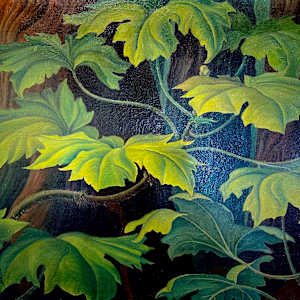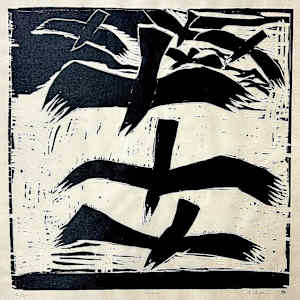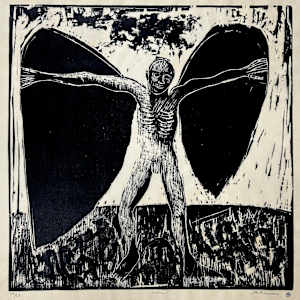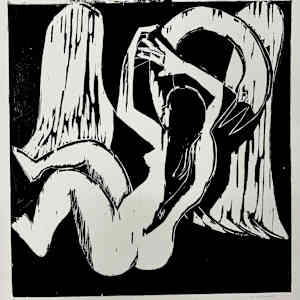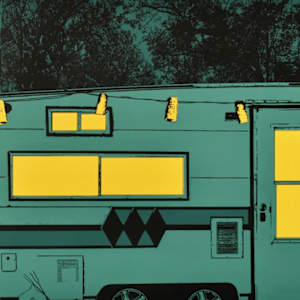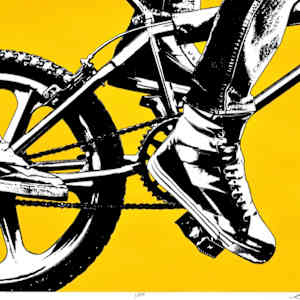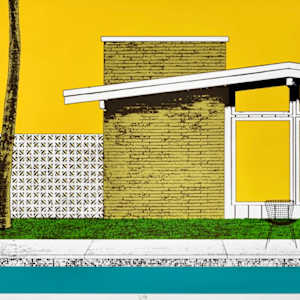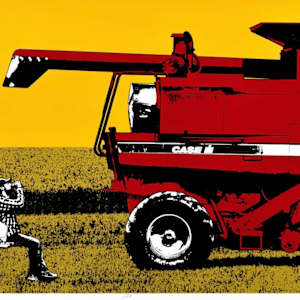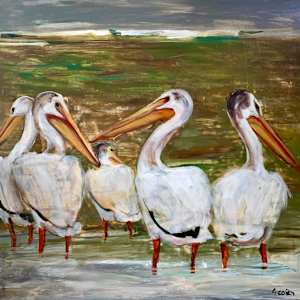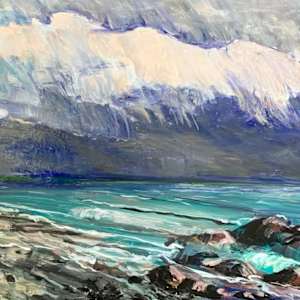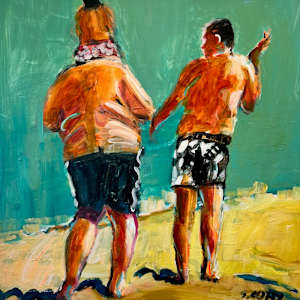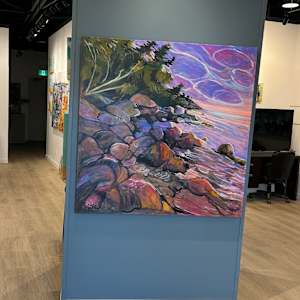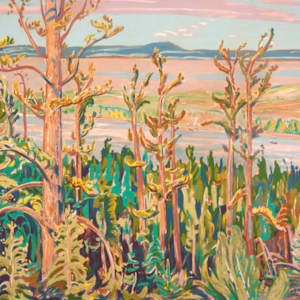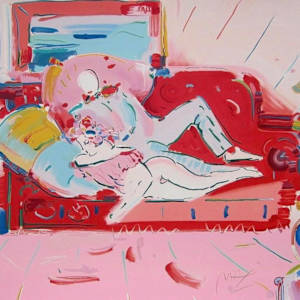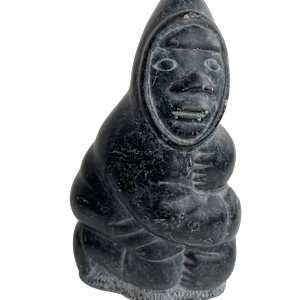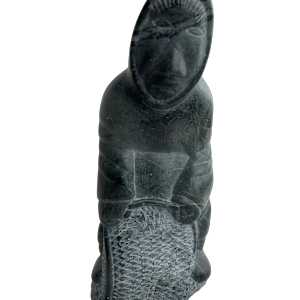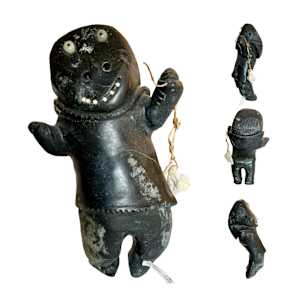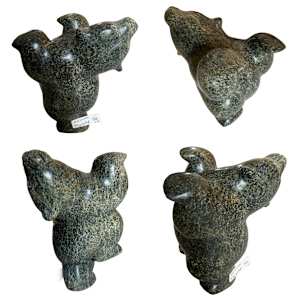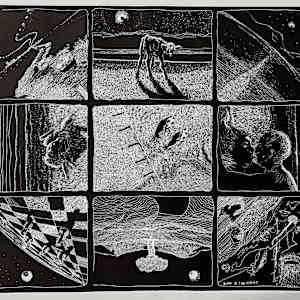Arthur Adamson (1926-2019)
Arthur, born in Winnipeg on January 8, 1926, began painting in his early 30s, inspired by his sister Joyce’s studies with George Swinton. He quickly became passionate about printmaking, experimenting with woodcuts to illustrate his poetry. Arthur’s creative journey led him to publish several books of poetry, including Bird Beast and Lover (1994), which featured his own woodblock prints. He was a key figure in the local arts community, collaborating with artists like Kelly Clark and Bill Lobchuk, and contributing to publications such as Prairie Fire and CV2.
Arthur's love for nature and outdoor adventures, including canoe trips through Canada's wilderness, influenced his artistic work, capturing the beauty of the Canadian Shield. A lifelong educator, he combined his love of literature and art, teaching French and English literature at the University of Manitoba while remaining active as a painter and printmaker. His legacy continues through his art, poetry, and contributions to the Manitoba cultural community.
Eric Ouimet
Eric Ouimet is a professional graphic artist and screen printer based in Manitoba, Canada. Raised on a farm near Ste-Agathe, he developed a passion for design that led to a successful career in graphic arts. Known for his distinctive large-format acrylic works on wood, Ouimet blends techniques from his award-winning serigraphs into these pieces, creating bold, visually striking works that emphasize texture and character.
Recurring themes in his art include nostalgia and a deep appreciation for architecture, which inform much of his imagery. Ouimet’s work resonates on both intimate and grand scales, maintaining the same unique style regardless of the medium or size. His pieces can be found in private collections around the world, and his larger wood panel works are available through Mayberry Fine Art in Winnipeg, while screen prints can be found at Canvas Gallery in Toronto and Pulse Gallery in Winnipeg.
Simon Tookoome
Simon Tookoome (b. Tariunnuaq [Chantrey Inlet], NU – d. 2010) was a renowned Inuit artist, carver, jeweller, and storyteller, deeply rooted in the traditional knowledge of his people. Raised on the land, his art reflects his lived experiences, Inuit mythology, and shamanic traditions.
Tookoome began as a carver of bone and soapstone in the 1960s but found greater artistic freedom in drawing, developing a distinctive graphic style characterized by bold contour lines, saturated colors, and dynamic compositions. His imagery often featured hybrid animals, spiritual themes, and interconnected communities, as seen in works like Rainbow Dance (2006).
A founding member of the Baker Lake print shop, Tookoome was celebrated for his printmaking and won the Norma Fleck Award for his children’s book The Shaman’s Nephew: A Life in the Far North (1999), co-authored with Sheldon Oberman. His work has been widely exhibited and featured multiple times in the Inuit Art Quarterly.
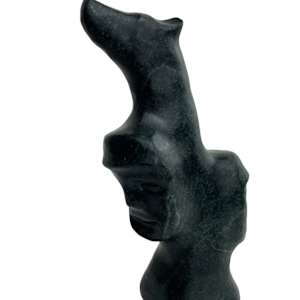
Steve Prudente
Steve Prudente was a sculptor artist from Winnipeg, who later moved to Vancouver to work. Steve helped to co-found “The Subway Group of Artists”(Winnipeg’s 1970s Underground Art Movement) and their continuous struggle to exhibit their work. They were one of Canada’s Four Great Artist Coalitions of the 1900s-Group of Seven, Toronto Eleven, Regina Five and Subway. Included is the history of the group, biographies and examples of their works of art. In the early 70s there was not much of a contemporary gallery scene in Winnipeg where the Subway Group was formed… the underground art movement. Their work was not mainstream landscapes and flowers and they were bonded by their individual pursuits in creating their more contemporary passions. The core members were Robert Achtemichuk, Tony Allison, David Anderson, Noel Bebee, Ken Chernavitch, Arthur Horsfall MSA,RCA, E.J. (Ted) Howorth, Mark Jenkyns (Group leader), Wade Jones, Larry Kissick MSA, John Mair, Luther Pokrant RCA, Steve Prudente, Bill Putco, Stan Taniwa. Later additions were Adrienne Diner, Ted Godwin OC,LLD,RCA, Norval Morriseau OC, RCA and F.J. Visscher.
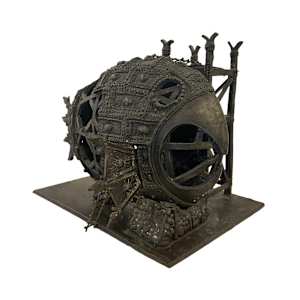
Barbara Cook Endres
Barbara Cook Endres (1922 - 2010) studied at the Ontario College of Art, where she received multiple accolades, including the Lieutenant-Governor’s medal for design. After moving to Winnipeg in 1946, she became a full member of the Manitoba Society of Artists (MSA) and held a solo show at the Winnipeg Art Gallery in 1949. Her artistic work included portraits, landscapes, and large murals, with notable commissions at Shea’s Brewery and St. Boniface Hospital. In 1951, she worked with Professor Charles Comfort on a mural in Vancouver.
Barb also contributed to the local arts community as an archivist for the MSA, documenting its history, mentoring younger artists, and volunteering for events. She returned to painting in the 1990s, creating a large mural for the Deer Lodge Community Club. Barb’s work has been showcased in private collections and is part of the permanent collection at the Winnipeg Art Gallery.

Allen Hessler
Allen Hessler, born in Winnipeg, Manitoba to Austrian immigrants, was raised and educated in his hometown, where he studied Illustration and Graphic Design before attending the University of Manitoba School of Fine Art. After graduation, he received a French Government scholarship to study at École Nationale Supérieure des Beaux-Arts in Paris.
Hessler taught silkscreen and woodcut printing at the University of Manitoba School of Art from 1981 to 1987 before relocating to Montréal, where he worked in his Bleury Street Haunted studio until 2005. He currently works at his studio in Saint Henri.
A member of the Conseil de l’Estampe Québécois, Hessler received Québec Arts Council project grants for two print portfolios, Abbott Cadabra (1989) and Le Quartier Hanté (1997). He taught at institutions such as the Saidye Bronfman Art Center, Dawson College, and John Abbott College, and served as a counselor at Omer DeSerres from 1993 to 2013. A member of ARTS NDG, he has exhibited widely, including solo exhibitions at Crystal Racine Gallery, such as Rencontres / Encounters (2012) and Voyage Graphique (2015).
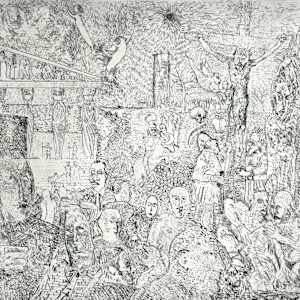
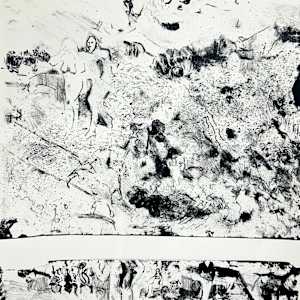
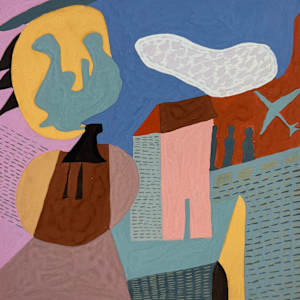
Samson Kingalik
Samson Kingalik (1937–2011) was a renowned Inuit sculptor from Quebec, Canada, celebrated for his masterful carvings in steatite and soapstone. Known for his exceptional attention to detail, Kingalik created expressive figures, often focusing on the human form and wildlife, particularly seals. His ability to capture lifelike expressions and interactions in his sculptures set him apart, drawing comparisons to the painter Mary Cassatt for his skill in depicting relationships between subjects.
His work is held in major collections, including the National Gallery of Canada and the McCord Museum in Montreal, which houses several of his notable pieces, including a striking female portrait. Kingalik’s sculptures are highly valued, with prices ranging from $750 to $4,000, reflecting both his technical expertise and the deep cultural significance of his art.
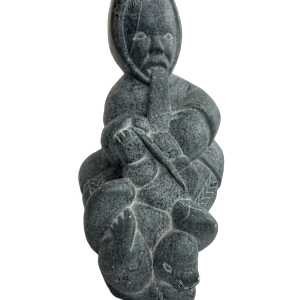
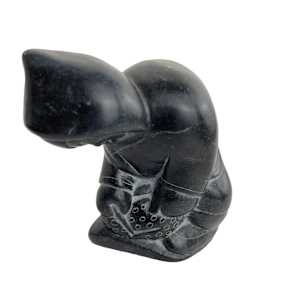
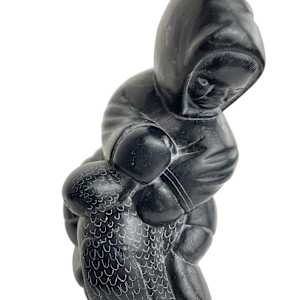
Paulosie Kasudluak
Paulosie Kasudluak (1928– ) is an Inuit sculptor from Nastapoka Island, now residing in Inukjuak. He began carving in 1952 after observing other artists at work. Due to an arm condition, he specializes in smaller pieces, often depicting seals, his favorite subject. His siblings, Simon Kasudluak and Sarah Nastapoka, are also artists. Kasudluak’s work reflects a deep connection to Arctic wildlife and Inuit traditions, contributing to the rich legacy of Inuit sculpture.
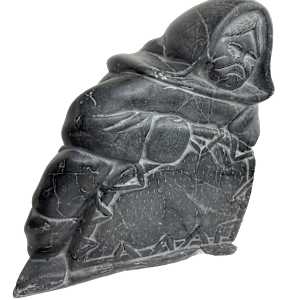
Johnny Kavik
John Kavik was a sculptor and ceramicist from Uqsuqtuuq (Gjoa Haven), NU, who began carving later in life after working in the mines of Kangiqliniq (Rankin Inlet). His work focused on human figures, particularly mother-and-child sculptures, often characterized by rough textures, minimal detailing, and deep incisions for facial features and clothing.
In addition to carving, Kavik created ceramics featuring human and animal motifs. His work has been widely exhibited in Canada, the U.S., and Japan, with major collections at the Art Gallery of Ontario, Vancouver Art Gallery, and Winnipeg Art Gallery.
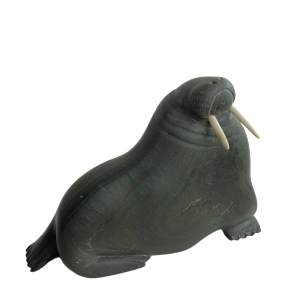
W.P. Weston
W.P. Weston (1879–1967) was a British-born Canadian painter and printmaker, best known for his dramatic landscapes of British Columbia. Trained in London, England, he immigrated to Vancouver in 1909, where he worked as an influential art teacher before devoting himself fully to painting in 1946. His style, influenced by Japanese art and the Group of Seven, emphasized sculptural forms and bold, linear compositions. A key figure in the Canadian art scene, he was a founding member of the Canadian Group of Painters and the Federation of Canadian Artists. His work is held in major public collections, including the National Gallery of Canada and the Vancouver Art Gallery.
